
A Recap of the 2021 Harmful Algal Bloom (HAB) Illness Season
The 2021 HAB season was one for the books! An uptick in dermal illness complaints and yellow and purple blooms are just a few of the interesting reports investigated by our program this year.
How the HAB Program Investigates Health Complaints
When our HAB program receives a health complaint, we gather information from the complainant by administering a standardized questionnaire and review the information provided to determine the likelihood that the reported illness is related to exposure to blue-green algae (also known as cyanobacteria). We gather information on the nature of the exposure, the environmental conditions observed at the time of exposure, symptoms experienced (including time-to-symptom onset), and health history. Our investigation typically includes working with our partners at the Department of Natural Resources (DNR) to review available photos and satellite imagery of the water conditions at the time of the exposure, and in some cases, we may collect and test water samples of the implicated water body to determine levels of blue-green algae and their toxins.
Complaint Summary
This year, we received 19 total HAB-related illness complaints regarding 15 human and four animal illnesses. After thorough investigation, we concluded that three human illnesses and one dog illness were potentially related to HAB toxicity. These cases had reported exposure to blue-green algae in water bodies located in Taylor, Juneau, and Dunn counties.
 |
|
Human Cases |
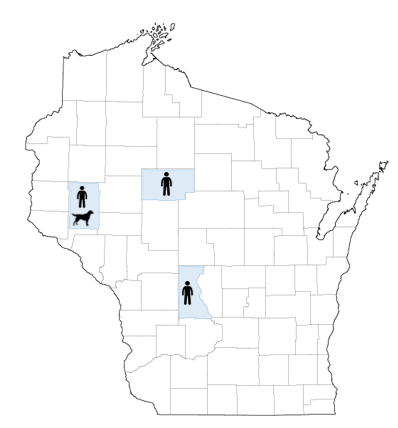
All possible human cases were age 5 and under and experienced gastrointestinal symptoms including vomiting and diarrhea. One case also developed throat irritation.
Ingestion of water containing blue-green algae and their toxins was the likely exposure route for all cases.
These reports are consistent with data observed at the national level. The Center for Disease Control and Prevention's (CDC) One Health Harmful Algal Bloom System data summaries for 2016-2018 and 2019 show that gastrointestinal symptoms like diarrhea and vomiting are commonly reported symptoms of blue-green algae poisoning, and these reported illnesses often occur in children.
|
Children: An Important Risk Group
 |
|
Children are more susceptible to the effects of blue-green algae toxins and have a higher likelihood of getting sick compared to adults. Children spend more time in water and are more likely to engage in hand-to-mouth activity, which increases their likelihood for exposure. Once exposed, children can experience more severe health effects because they tend to ingest more water per their body size compared to adults, and have more sensitive skin. Children should always be supervised when swimming in any body of water. |
 |
|
Dog Cases |
Four reported animal health complaints all involved illnesses in dogs. Only one of these illnesses is believed to be associated with blue-green algae poisoning. This dog likely ingested water from a lake experiencing a bloom and developed severe neurologic symptoms as a result. One reported dog illness was determined to be related to water intoxication as confirmed by both a Department of Health Services (DHS) public health veterinarian and the dog’s private veterinarian.
Is it Blue-Green Algae or Something Else?
Reported illnesses in dogs are often ruled out because a cause of illness other than blue-green algae toxicity is more likely or confirmed by a veterinarian. Other common causes of illness that present signs of illness similar to blue-green algae toxicity include:
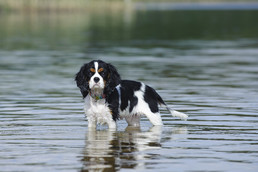 |
|
- Heat related stress
- Water intoxication
- Pesticide exposure
- Exposure to other poisonous substances.
|
Learn more about how to protect your dog by visiting our Blue-Green Algae and Dog Safety fact sheet.
This year’s Most Unique Bloom Awards go to…
Did you know that blue-green algae blooms are not always blue or green? Different species of cyanobacteria can produce blooms of a variety of colors, including white, red, brown, and even purple and gold!
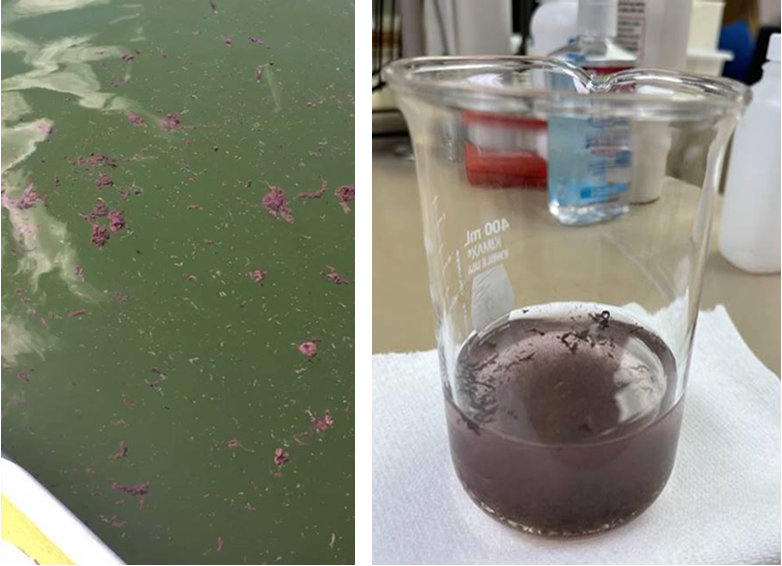 The above purple mats are from a benthic (bottom-dwelling) species of cyanobacteria known as Planktothrix rubescens, which produces a ruby-colored pigment. Benthic cyanobacteria are more common in lakes with clear water, since sunlight must reach the bottom of the lake where they grow.
Benthic mats typically accumulate high cell concentrations and may become a health hazard when their cells are producing toxins. Ingesting these high concentrations could cause serious illness, especially in pets that play with or ingest the mats.
The good news is that floating mats like these are usually easy to see and therefore easier to avoid. Though the water may look clear, people and pets should stay away from areas where floating, scummy mats are present since toxins may still be present.
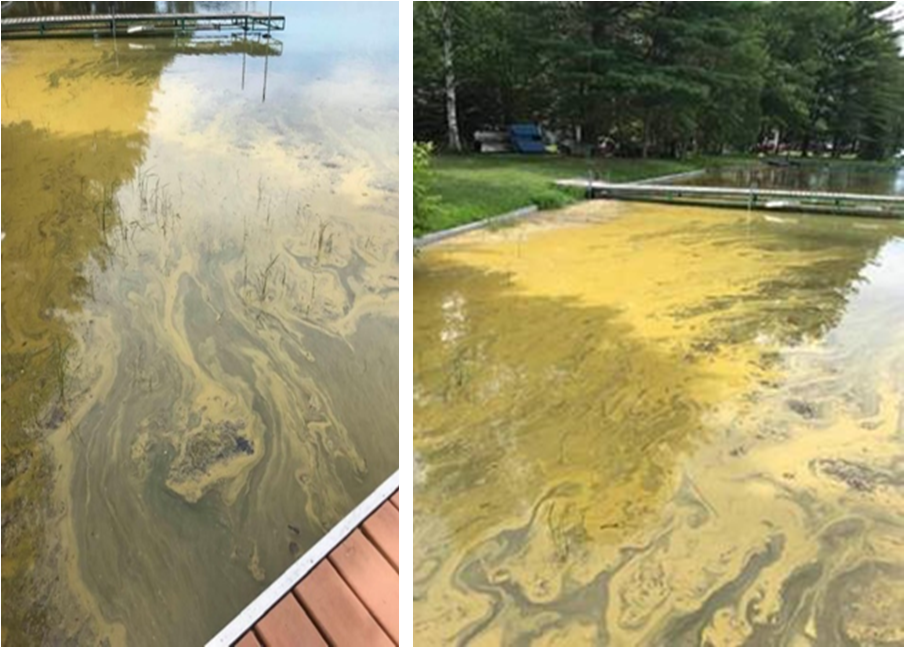 This mustard-colored bloom shows planktonic (microscopic free-floating) cyanobacteria. It is the genus Microcystis, which is the most common type of bloom-forming cyanobacteria in Wisconsin lakes. The color is unusual as Microcystis is usually mint green, especially when it is growing. The photos above show a population producing golden pigments.
Pollen: A Doppelgänger!
New HAB Program Coordinator in the spotlight!
Check out this recent article published by the University of Wisconsin Sea Grant. This story features an interview with Jordan, where she explains her role as DHS’s Harmful Algal Blooms Program Coordinator.
This summer, Jordan was able to look at a blue-green algae bloom for the first time in person!
|
|
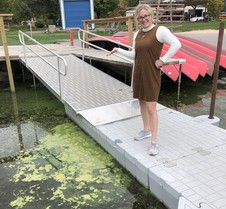 |
 |
|
Let's Get Social! |
The following sample post and accompanying photos are available for local and tribal health department use in social media messaging.
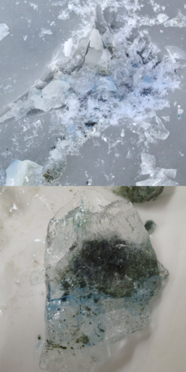 |
|
Quiz time! What is the blue substance in the ice cracks?
a) Antifreeze
b) Blue-green algae (cyanobacteria)
c) Hair dye
d) Petroleum
e) Porta Potty chemical spill
Answer: b. Even during winter, blue-green algae (also known as cyanobacteria) can bloom in lakes and rivers under the ice. Blue-green algae look for sunlight under ice cracks and areas where the ice is clear. The freezing and thawing near the surface caused the bacteria to die and release blue pigment. Blue-green algae can produce toxins that can make people and animals sick. Even though this was a rare sighting and you might be tempted to investigate, never touch a substance you are not sure about. If you see something like this, be sure to notify your local or tribal public health agency!
|
Stay in Touch
 |
|
Missed a past issue? Previous issues are available on our Resources for Health Professionals webpage.
Email us your burning questions! If others can benefit from hearing the answer to your question, we’ll feature it in a future issue.
Remember that we are always available for consultation on any HAB health-related issue by email or phone (608-266-1120).
|
|